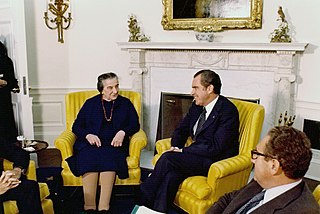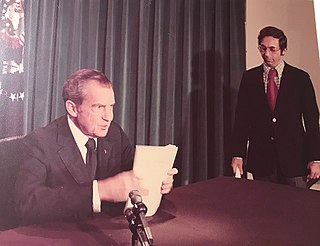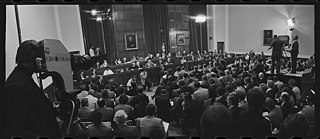
Henry Alfred Kissinger was an American diplomat and political scientist who served as United States Secretary of State from 1973 to 1977 and National Security Advisor from 1969 to 1975, in the presidential administrations of Richard Nixon and Gerald Ford.

Richard Milhous Nixon was the 37th president of the United States, serving from 1969 until his resignation in 1974. A member of the Republican Party, he previously served as a representative and senator from California and as the 36th vice president from 1953 to 1961 under President Dwight D. Eisenhower. His presidency saw the reduction of U.S. involvement in the Vietnam War, détente with the Soviet Union and China, the Apollo 11 Moon landing, and the establishment of the Environmental Protection Agency and Occupational Safety and Health Administration. Nixon's second term ended early when he became the only U.S. president to resign from office, as a result of the Watergate scandal.

The Watergate scandal was a political scandal in the United States involving the administration of President Richard Nixon which ultimately led to Nixon's resignation. It revolved around members of a fundraising organization associated with Nixon's 1972 re-election campaign breaking into the Democratic National Committee headquarters located in the Watergate Office Building in Washington, D.C., on June 17, 1972, and Nixon's subsequent attempts to conceal his administration's involvement.

Melvin Robert Laird Jr. was an American politician, writer and statesman. He was a U.S. congressman from Wisconsin from 1953 to 1969 before serving as Secretary of Defense from 1969 to 1973 under President Richard Nixon. Laird was instrumental in forming the administration's policy of withdrawing U.S. soldiers from the Vietnam War; he coined the expression "Vietnamization," referring to the process of transferring more responsibility for combat to the South Vietnamese forces. First elected in 1952, Laird was the last living Representative elected to the 83rd Congress at the time of his death.
The silent majority is an unspecified large group of people in a country or group who do not express their opinions publicly. The term was popularized by U.S. President Richard Nixon in a televised address on November 3, 1969, in which he said, "And so tonight—to you, the great silent majority of my fellow Americans—I ask for your support." In this usage it referred to those Americans who did not join in the large demonstrations against the Vietnam War at the time, who did not join in the counterculture, and who did not participate in public discourse. Nixon, along with many others, saw this group of Middle Americans as being overshadowed in the media by the more vocal minority.

The Nixon Doctrine was the foreign policy doctrine of Richard Nixon, the 37th president of the United States from 1969 to 1974. It was put forth during a press conference in Guam on July 25, 1969, by Nixon, and later formalized in his speech on Vietnamization on November 3, 1969.

The history of the United States from 1964 to 1980 includes the climax and end of the Civil Rights Movement; the escalation and ending of the Vietnam War; the drama of a generational revolt with its sexual freedoms and use of drugs; and the continuation of the Cold War, with its Space Race to put a man on the Moon. The economy was prosperous and expanding until the recession of 1969–70, then faltered under new foreign competition and the 1973 oil crisis. American society was polarized by the ultimately futile war and by antiwar and antidraft protests, as well as by the shocking Watergate affair, which revealed corruption and gross misconduct at the highest level of government. By 1980 and the seizure of the American Embassy in Iran, including a failed rescue attempt by U.S. armed forces, there was a growing sense of national malaise.

Edmund Sixtus Muskie was an American statesman and political leader who served as the 58th United States Secretary of State under President Jimmy Carter from 1980 to 1981, a United States Senator from Maine from 1959 to 1980, the 64th Governor of Maine from 1955 to 1959, and a member of the Maine House of Representatives from 1946 to 1951. He was the Democratic Party's nominee for vice president in the 1968 presidential election.
A United States presidential doctrine comprises the key goals, attitudes, or stances for United States foreign affairs outlined by a president. Most presidential doctrines are related to the Cold War. Though many U.S. presidents had themes related to their handling of foreign policy, the term doctrine generally applies to presidents such as James Monroe, Harry S. Truman, Richard Nixon, Jimmy Carter and Ronald Reagan, all of whom had doctrines which more completely characterized their foreign policy.

Gerald Ford's tenure as the 38th president of the United States began on August 9, 1974, upon the resignation of President Richard Nixon, and ended on January 20, 1977. Ford, a Republican from Michigan, had been appointed vice president on December 6, 1973, following the resignation of Spiro Agnew from that office. Ford was the only person to serve as president without being elected to either the presidency or the vice presidency. His presidency ended following his narrow defeat in the 1976 presidential election to Democrat Jimmy Carter, after a period of 895 days in office.

The 1972 visit by United States president Richard Nixon to the People's Republic of China was an important strategic and diplomatic overture that marked the culmination of the Nixon administration's establishment of relations between the United States of America and the People's Republic of China after years of American diplomatic policy that favored the Republic of China in Taiwan. The seven-day official visit to three Chinese cities was the first time a U.S. president had visited the PRC; Nixon's arrival in Beijing ended 25 years of no communication or diplomatic ties between the two countries and was the key step in normalizing relations between the U.S. and the PRC. Nixon visited the PRC to gain more leverage over relations with the Soviet Union, following the Sino-Soviet split. The normalization of ties culminated in 1979, when the U.S. established full diplomatic relations with the PRC.

Anna Chennault, born Chan Sheng Mai, 陳香梅, also known as Anna Chan Chennault or Anna Chen Chennault, was a war correspondent and prominent Republican member of the U.S. China Lobby. She was married to American World War II aviator General Claire Chennault.
"Peace with Honor" was a phrase U.S. President Richard Nixon used in a speech on January 23, 1973 to describe the Paris Peace Accords to end the Vietnam War. The phrase is a variation on a campaign promise Nixon made in 1968: "I pledge to you that we shall have an honorable end to the war in Vietnam." The Accords specified that a ceasefire would take place four days later. According to the plan, within sixty days of the ceasefire, the North Vietnamese would release all U.S. prisoners, and all U.S. troops would withdraw from South Vietnam. On March 29, 1973, the last U.S. soldier left Vietnam. On 30 April 1975, Saigon was taken by North Vietnamese troops.

Richard Nixon's tenure as the 37th president of the United States began with his first inauguration on January 20, 1969, and ended when he resigned on August 9, 1974, in the face of almost certain impeachment and removal from office, the only U.S. president ever to do so. He was succeeded by Gerald Ford, whom he had appointed vice president after Spiro Agnew became embroiled in a separate corruption scandal and was forced to resign. Nixon, a prominent member of the Republican Party from California who previously served as vice president for two terms under president Dwight D. Eisenhower, took office following his narrow victory over Democrat incumbent vice president Hubert Humphrey and American Independent Party nominee George Wallace in the 1968 presidential election. Four years later, in the 1972 presidential election, he defeated Democrat nominee George McGovern, to win re-election in a landslide. Although he had built his reputation as a very active Republican campaigner, Nixon downplayed partisanship in his 1972 landslide re-election.

On August 8, 1974, U.S. President Richard Nixon delivered a nationally-televised speech to the American public from the Oval Office announcing his intention to resign the presidency the following day due to the Watergate scandal.
The 1970 State of the Union Address was given by Richard Nixon, the 37th United States president, on January 22, 1970, to both houses of the 91st United States Congress. He said, "I say this not only because 1970 marks the beginning of a new decade in which America will celebrate its 200th birthday. The seventies will be a time of new beginnings, a time of exploring both on the earth and in the heavens, a time of discovery. But the time has also come for emphasis on developing better ways of managing what we have and of completing what man's genius has begun but left unfinished.
The 1973 State of the Union Address was delivered to the 93rd United States Congress as a series of six written messages from February 2 to March 14, 1973. The first message was an overview, which was then followed by five additional messages, each of which focused on a specific public policy theme.

The impeachment process against Richard Nixon was initiated by the United States House of Representatives on October 30, 1973, during the course of the Watergate scandal, when multiple resolutions calling for the impeachment of President Richard Nixon were introduced immediately following the series of high-level resignations and firings widely called the "Saturday Night Massacre". The House Committee on the Judiciary soon began an official investigation of the president's role in Watergate, and, in May 1974, commenced formal hearings on whether sufficient grounds existed to impeach Nixon of high crimes and misdemeanors under Article II, Section 4, of the United States Constitution. This investigation was undertaken one year after the United States Senate established the Select Committee on Presidential Campaign Activities to investigate the break-in at the Democratic National Committee headquarters at the Watergate office complex during the 1972 presidential election, and the Republican Nixon administration's attempted cover-up of its involvement; during those hearings the scope of the scandal became apparent and the existence of the Nixon White House tapes was revealed.
The following is a timeline of the presidency of Gerald Ford from August 9, 1974, when Ford became the 38th president of the United States, upon the resignation of Richard Nixon, to December 31, 1974.
The 1969 State of the Union Address was given by Lyndon B. Johnson, the 36th president of the United States, on Tuesday, January 14, 1969, to the 91st United States Congress in the chamber of the United States House of Representatives. It was Johnson's sixth and final State of the Union Address. Presiding over this joint session was House speaker John W. McCormack, accompanied by Vice President Hubert Humphrey, in his capacity as the president of the Senate.











